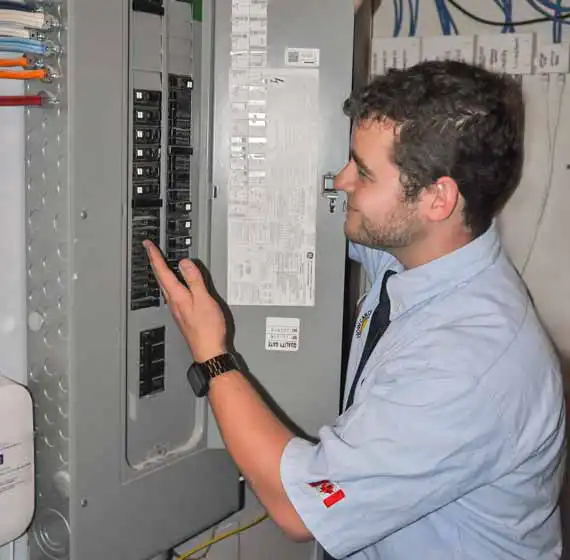
Same Day Service
Since 1992
Call The Gentleman Pros Now!
(403) 755-4914

Have one of our Red Deer electricians make your life easier by installing or upgrading your electrical panel.
Are you tired of constantly going to your electric panel because your circuit breakers keep tripping? If your answer is yes, it’s likely time to think about getting a new electrical panel, also known as a breaker box, fuse box, electrical service panel, fuse panel, or load center.
Given the multitude of devices we use nowadays if your electrical panel is 25 or more years old, you should really consider replacing it. Even if your panel is 15 years old, you might find it is unable to meet your current electrical demands. However, there’s no need to worry because The Gentlemen Pros Red Deer electricians are here to assist you.

They will carefully assess your current and future requirements and promptly determine the right size for your new panel. With their expertise, they will efficiently install it, ensuring minimal disruption to your routine.
To start, simply reach out to one of our attentive Customer Care agents today at (587) 797-2685. They will be happy to assist you in booking an appointment at your convenience. Or book a visit online.
Wouldn’t it be great to not have to worry about blowing a circuit and say goodbye to those frustrating trips to your electric panel?
Give us a call and let us take care of your electrical panel needs!
Grounding and bonding are important pieces of your house’s electrical safety system that help protect you and your home from electrical hazards like shocks and fire.
Grounding is also called earthing and it involves connecting your electrical system to the ground, usually through a metal rod or a wire buried in the earth that is connected by a copper wire to the grounding bus bar in your electrical panel.
Bonding is connecting the conductive non-current carrying parts of your electrical system together with other conductive parts in your home using copper wiring. It creates a conductive path between these items and connects them to the grounding bus bar in the electrical panel. Items that become bonded together can include metal water and gas pipes, ductwork, junction boxes, and outlets and switches. Please check the applicable codes in your area.
Bonding provides electrical currents from an indirect lightning hit or currents that have escaped from the designed circuit (possibly due to frayed wires or a loose connection) a safe route to return to their source without causing damage or injury.
Without the grounding and bonding system, the stray or excess electricity would use any conductive item it could reach in its route back to its source (either the grid or the ground).
Conductive means electricity can flow through it and some things are more conductive than others. For example, metals are more conductive than water and water is more conductive than ceramics, wood, and plastics.
And guess what else is conductive? You — yes, you are conductive and you most definitely do not want electricity to use you as part of its path back to its source. If it did, the electricity could cause serious injury and even death. The copper wires that bond the various items together run to the electrical panel and connect to the ground bus bar (sometimes a combined neutral and ground bus bar).
From the ground bus bar, the electricity becomes diverted either to the ground or back to the grid depending on where the electricity came from. It will go to ground through a thick copper or in rare instances, aluminum wire — called the main grounding conductor — that is connected to either a buried copper grounding plate, a copper grounding rod that is driven deep into the earth, or a metal pipe extending into the house from an underground water supply. Or it will travel through a wire that connects the ground bus bar to the neutral bus bar and through the neutral bus bar back to the grid.
When your electrical system is operating properly, the grounding and bonding system will not carry any electricity. It only carries electricity when there is a problem.
Per the current Canadian electrical code, our homes must become grounded. If you would like to learn more about bonding and grounding, check this out.
In a house’s electrical system, several parts become connected to make up the grounding and bonding system. Here are the main components:
A grounding electrode is a metal (usually copper) rod or plate that is buried in the earth near your house. It serves as the main connection point between your home’s electrical system and the ground. It is connected to your home by the main grounding conductor.
Usually referred to as the grounding or ground rod or grounding plate.
This is the fancy word for the thick copper wire that connects the main electrical panel to the grounding electrode buried in the earth. It provides a pathway for an electrical current to flow from your home and into the ground when it is traveling outside the designed circuit.
The wire is sometimes an aluminum wire, but rarely.
The grounding wires coming from your house’s different branch circuits become connected to the grounding bus bar which is located inside the electrical panel.
The main grounding conductor, the thick copper wire, connects the grounding bus bar to the buried grounding electrode completing the path to the earth.
Another wire connects the grounding bus bar to the neutral bus bar.
Some electrical panels have a combined grounding/neutral bus bar.
Grounding wires are bare or green insulated copper wires which run parallel with the hot and neutral wires throughout your electrical system. The copper wires connect all the outlets, switches, appliances, and other items that need to become bonded on all the branch circuits to the grounding bus bar in the electrical panel.
Grounding wires are a bit of a misnomer. They should really be called bond or bonding wires because these wires connect the various parts and bond them together. They carry the electricity that is outside the designed circuit safely back to the electrical panel.
Here one of two things happen. If the electricity being carried originated in the grid, the electricity runs from the grounding bus bar to the neutral bus bar and back to the grid.
If the electricity is from an indirect lightning source, the electricity travels through the grounding bus bar, through the main grounding connector, and into the ground through the grounding electrode (grounding bar or plate).
Grounded outlets are the three-pronged outlets you see in your home. The third prong is a grounding prong. This prong connects the plugged-in appliance’s grounding wire to your home’s grounding wires essentially bonding the appliance to the other bonded parts in the system. This provides a safe path for faulty currents to safely travel back to their source.
Since 1962, Canada’s National Electric Code has required three-prong grounded outlets in all newly built homes.
In some cases, the metal water and gas pipes in a house are also bonded with the other conductive parts in your home and then connected to the grounding system with copper wires. This helps to ensure that any electrical faults in these pipes safely return to their source.
These interconnected components work together to provide a safe path for stray electrical currents and protect you and your home against electrical hazards like shocks, sparks, and fires.
It is imperative that your house is properly bonded and grounded. If you have any concerns or questions, please reach out. Our number is (587) 797-2685 or book online.
Contact us today to learn more about Red Deer electrical panels installations & updates.



